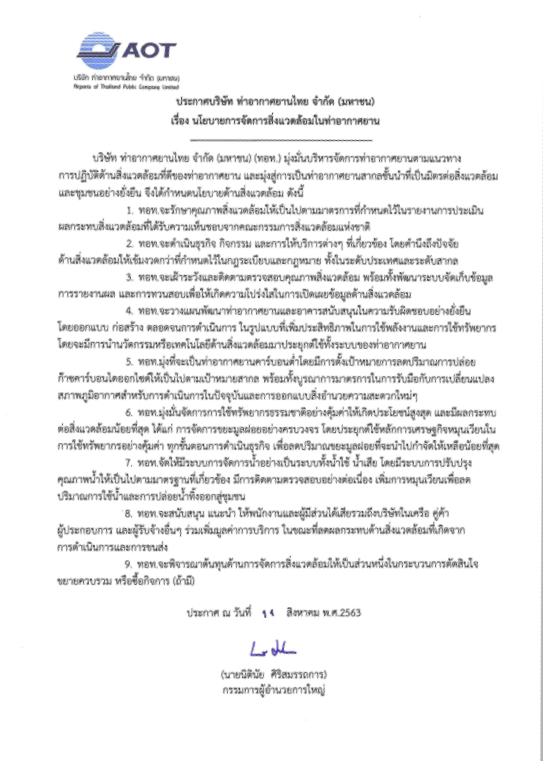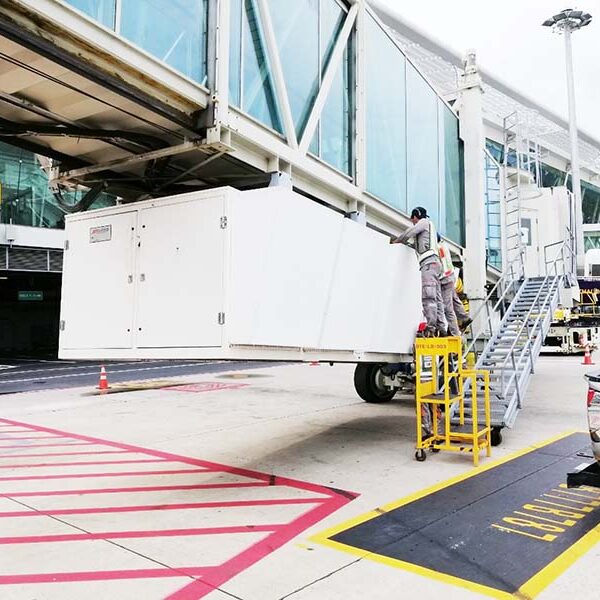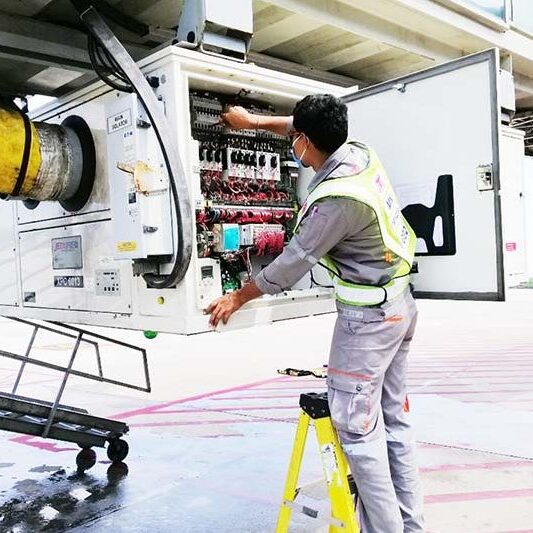Natural resource and Environmental Management
Importance
The operations, development, and expansion of infrastructures within airports necessitate a systematic approach to managing the business impact. This involves controlling both positive and negative impacts on various stakeholders, especially regulatory agencies, shareholders, investors, and securities analysts, who are interested in and have expectations for AOT’s management. AOT recognizes the significance of environmental impacts, which can be categorized into specific management areas: noise, air quality, water and wastewater, waste, and biodiversity. The said environmental issues can widely impact in various ways. In this regard, AOT is aware of and recognizes the importance of addressing potential problems in accordance with established environmental management measures and plans. This ensures the operations align with environmental sustainability, enhance value, and respond to stakeholder expectations, adhering to domestic and international sustainability assessment criteria.
Policies and Approaches Management
Airport Environmental Management Policy

AOT is committed to operating all six of its responsible airports according to best practices in environmental management, aiming to become low-carbon international airports by adhering to the framework of the Airport Carbon Accreditation (ACA) Project of the Airports Council International (ACI). To achieve this, AOT established the AOT Sustainable Development Subcommittee in 2023 to drive policies and action plans as well as closely following up the performance of working groups of every department to be in line with the specified policies. Moreover, the environmental management at 6 airports is operated in compliance with the AOT’s Corporate Plan of the fiscal years 2023-2027 revised edition (fiscal year 2023): Sustainable Development under Airport Strategic Positioning and the Airport Environment Management Policy, aiming to operate in the same direction and comply with the requirements of the laws.
AOT Green ICT Management Policy
AOT has established the Green ICT Management Policy to guide the organization towards environmentally friendly ICT practices. This comprehensive policy encompasses energy efficiency, ICT resource management, and service quality, with a focus on four key components as follows:
- Equipment Lifecycle
- End User Computing
- Enterprise Computing
- ICT for GHG emission reduction (ICT as a Low – Carbon Enabler)
See more details

Important Environmental Management Guidelines for Airports
At present, AOT follows the 5 areas of important environmental management guidelines as follows:
- Noise management
- Air quality management
- Water and wastewater management
- Waste management
- Biodiversity
1
Noise Management
The Noice Balanced Approaches of the International Civil Aviation Organization (ICAO) has been applied to AOT’s airport operations. The Balanced Approaches are as follows:
- Reduction of noise at source: Encourage airlines to use low-noise aircraft design or engines with low noise emission and optimize aircraft loading.
- Land-use planning and management: Provide the relevant information, such as airport development plans and noise impact areas, to determine the appropriate use of land.
- Noise abatement operational procedures: Require airlines operating at the airport to adhere to landing and take-off procedures that minimize noise pollution while having no effect on safety. AOT can effectively mitigate noise pollution while maintaining capacity, preferential runway use, and traffic efficiency and accessibility.
- Operating restrictions: Announce restrictions in the Aeronautical Information Circular (AIC) for aircraft operating their flights at Suvarnabhumi Airport, Don Mueang International Airport, and Chiang Mai International Airport to adhere to the noise standards specified in Chapter 3 of Annex 16 of the Chicago Convention on International Civil Aviation.
Moreover, aircraft noise level is regularly monitored and measured through permanent and temporary noise monitoring stations as follows:
Permanent noise monitoring stations
- Suvarnabhumi Airport currently has 19 permanent stations and 2 mobile stations while additional 6 permanent stations are being prepared to install during the construction of Runway 3 and additional 5 permanent stations during the construction of Runway 4.
- Phuket International Airport has 4 permanent stations and 2 mobile stations.
- Chiang Mai International Airport has 4 permanent stations and 2 mobile stations.
- Don Mueang International Airport is prepared to install 14 permanent stations and
2 mobile stations during the construction period of Don Mueang International Airport Development Project, phase 3.
Temporary noise monitoring stations
Don Mueang International Airport and Mae Fah Luang – Chiang Rai International Airport measure aircraft noise levels for 7 consecutive days twice a year.
Air Quality Management
AOT has implemented comprehensive measures to prevent and mitigate air quality impacts from ground-level and aircraft pollution, specifically focusing on reducing PM 2.5. The measures include:
2
- Require engine shutdowns and restrict Auxiliary Power Unit (APU) while arriving at the parking bay or at the Passenger Loading Bridge (PLB), and use the Ground Power Unit (GPU) and Pre-Conditioned Air (PCA) provided through the airport’s utility infrastructure.
- Optimize the airport traffic flow, especially in passenger terminal areas and parking areas, to avoid congestion and reduce air pollutants.
- Maintain vehicles and Ground Support Equipment (GSE) to prevent air pollutants from being emitted over the legal limits.
- Encourage using eco-friendly vehicles such as electric vehicles (EV).
- Encourage employees and airport users to use more the public transport system to reduce energy consumption and air pollution from cars.
- Promote campaigns to avoid or reduce forest burning, especially for airports located in the risk areas of agricultural waste or wildfires.
AOT has set the air quality monitoring system for tracking, inspecting and surveilling air quality covering internal and external areas of the airport as follows:
- AOT operates a network of ambient air quality monitoring temporary stations at five major airports: Suvarnabhumi Airport, Don Mueang International Airport, Phuket International Airport, Chiang Mai International Airport, and Mae Fah Luang – Chiang Rai International Airport. These stations conduct air quality monitoring twice a year, over a continuous 7 days period. The Air Quality Index (AQI) is as follows:
- Nitrogen oxide (NOx)
- Carbon monoxide (CO)
- Total Hydrocarbons (THC)
- Total suspended particles (TSP)
- Particulate matter 10 micrometers (PM10)
- Volatile organic compounds (VOCs)
- Wind direction and speed
The measurement results showed that the air quality was at standard criteria as required by law to monitor air pollution levels that may affect public health.
- Suvarnabhumi Airport installed 2 ambient air quality monitoring stations (permanent station).
- Don Mueang International Airport is prepared to install 2 ambient air quality monitoring stations (permanent station) during the construction period of Don Mueang International Airport Development Project, phase 3.
3
Water and Wastewater Management
AOT has managed water and wastewater to ensure sufficient quantities of water for operational consumption, including preventing and controlling problems that possibly affect the ecosystem and surrounding communities, both quantitatively and qualitatively. In addition, AOT has prepared the Environmental Impact Assessment (EIA) report, which considers impacts on the quality of surface water, hydrology, and drainage to communities, both in the construction and operational phase of the airport, in accordance with scientific principles, as well as through participation with communities and other stakeholders. Currently, the primary water sources utilized within the airport come from the Metropolitan Waterworks Authority, the Provincial Waterworks Authority, and the on-site water treatment system, relying on groundwater and surface water sources. Each airport implements water quality control process to ensure that the water supplied meets the standards set by the World Health Organization (WHO) for consumption water and monitors the quality of tap water inside the passenger terminals according to the Ministry of Public Health regulations monthly.
Furthermore, all AOT airports are equipped with a centralized wastewater treatment system that can sufficiently handle the daily wastewater volume. They also control and inspect the wastewater treatment operations to ensure of work efficiency, and check the quality of effluents in compliance with the legal standards. For Suvarnabhumi Airport, Don Mueang International Airport and Phuket International, the effluents completely passing the centralized wastewater treatment system will be additionally treated for reuse.
Suvarnabhumi Airport is AOT's main airport. Its water management is certified by the International Standard on Environmental Management System ISO 14001: 2015 for the management of the potable water supply system, airport drainage system, wastewater collection system, and wastewater treatment system.
AOT is collecting base case data to set water usage targets in this regard. The targets will consider AOT’s current water usage situation coupled with the water management context in each area of the airport, including local water management measures of the relevant government sectors.
See more details
Waste Management
4
AOT recognizes the growing national concern over waste management, including the insufficiency of disposal sites, greenhouse gas emissions from landfills, and the contamination of waste into the ecosystem, especially plastic waste. AOT is aware of these problems and manages them continually.
Waste Disposal
Since, Airports generate significant waste due to the high volume of passengers, consumption activities, and waste carried by aircraft, AOT therefore has set the waste management system, starting with a campaign for passengers and airport staff to reduce the rare of waste generation and separate waste before throwing it into the right bin. As such, specific waste bins are provided in the passenger terminals and office buildings, including bins for general and recycled wastes. Hazardous and infectious wastes will be separately collected and stored to be further hygienically disposed of according to the law and sanitation principles. In addition, the proper waste breakpoints for each type of waste, e.g., general and recycled wastes, are set up with local or private entities transferring wastes for disposal and maintaining the cleanliness of the area and routes where garbage trucks pass each time after complete collection. Hazardous waste from maintenance of various equipment such as oil, solvents, light bulbs, and other infectious waste from airport medical clinics will be disposed of by legally licensed companies.
See more details
Resource Efficiency and Circularity
AOT established the AOT Green ICT Management Policy to support the circular economy concept by emphasizing the procurement of electronic devices that are durable, reusable, and easily recyclable to minimize waste generation at the source. The policy will transform the working methods of AOT employees from an analog system - that relies on a lot of resources like paper - into a digital system that helps reduce waste, such as an e-Document system, and also support the use of IT resources with greater efficiency to reduce energy consumption, such as Virtualization Server and Cloud Computing. In addition, AOT also set a Green ICT Management Guideline for the concrete use of employees. The said guideline comprises four key components as follows:
- Equipment Lifecycle
- End User Computing
- Enterprise Computing
- ICT for GHG emission reduction (ICT as a Low – Carbon Enabler)
See more details
Biodiversity
AOT recognizes the importance of biodiversity conservation within and beyond its airport operations. To address this commitment, AOT has established a comprehensive biodiversity conservative framework aligned with stakeholder expectations and the company’s environmental management plans as follows:
- AOT conducts the Environment Impact Assessment (EIA) and Biodiversity Risk Assessment of all 6 airports to report EIA monitoring and identify causes of impact towards biodiversity resulting from business operations in 6 airports, then prescribes work plans to reduce and avoid severity of impacts.
- AOT consistently adopts the preventive measures of accidents from birds, such as managing bird’s food sources, habitat sites, and bird attractions. Also, AOT set appropriate method to disperse birds from the airport areas in order to eliminate their habituation. The dispersal methods have been developed, such as using of auditory deterrents or visual deterrents. All of which are operated by AOT’s staffs who are expertise in ornithology. AOT also hired consultants to make a research and assessment of aviation accidents prevention caused by birds and animals. The preventive measures against potential harms from birds and animals that enter the airport areas are as follows:
- Assess the environment and manage factors that attract birds and animals to seek food and live in the area, such as water drainage gutters, ditches, lawn area, ground condition, airside fences to prevent animal trespassing, resting area and waste breakpoints.
- Strictly control and disperse dangerous animals throughout 24 hours and give warning of any danger from animals.
- Assess and prioritize the potential risks that may cause harmful effects from birds and animals in the airport areas which result from the land-used activities in the 13 kilometers radius around the airport, such as fishing ponds, agricultural activities, etc.
- Review and improve preventive measures to be suitable for the ecosystem and up to date.
- Determine the implementation process and report when incident of bird strike occur.
- AOT organizes reforestation activities and mangrove forest restoration every year which can
respond to the biodiversity issues in an extensive manner for all living things, such as being
a nursery habitat for small aquatic animals, poultry habitats, food sources for land and aquatic animals, alleviate and prevent violence against living things due to natural disasters, store carbon through plants in the mangrove forest, etc. This will help restoration and regeneration of biodiversity for nature and society as well as indirect benefits for society, such as generating incomes for communal people surrounding mangrove forest.
See more details
Acticities
400 Hz GPU and PC Air Service and Maintenance Project



Being aware of air and noise pollution problems, AOT provided a 400 Hz Ground Power Unit and Precondition Air (PC Air), including Uninterrupted Power System (UPS) systems for aircraft that use AOT’s airport services. The said systems help save energy and reduce pollution in the airside area according to ICAO’s policy that requires the contracting states to control air and noise pollution without affecting passengers and operators in the airport area. AOT’s policy aims to be an environmentally friendly airport (Green Airport).
Sharing Data via One Drive to Reduce Paper Use
AOT promotes resource conservation and efficient files among its employees by implementing the one-drive system, which provides each individual with 1TB of storage capacity to facilitate file sharing and collaboration. When a file is shared, everyone can see it. The shared file can be set as a read-only or edited document. It can be used for tracking work, reporting progress, and checking the correctness of documents without printing out or circulating information for acknowledgment. Additionally, the documents will be printed out as necessary while encouraging employees to use more recycled paper. All employees are required to submit electronic documents to their supervisors for review and approval before printing through a one-drive system to avoid errors and unnecessary printing.
Complaint and Suggestion
AOT provides channels for receiving complaints on environmental issues covering noise and other impact issues to jointly support the sustainable solutions and establish a coordinating center for solving environmental impact problems at Suvarnabhumi Airport. There are 2 main missions, as follows:
Community Relations Work
Visiting the areas to meet and clarify various issues with the public for clear understanding about AOT’s operations and solutions to impact issues, and following up the situations in communities and surrounding areas of the airport to report issues of public opinion or complaints to AOT.
Complaints Receipt Service
(Call Center)
Receiving complaint and answering inquiries regarding procedures for noise impact compensations caused by Suvarnabhumi Airport’s operations, work plan procedures, results of problem solving, and also provide other relevant information in case of inquiring in-dept information of AOT. The Center will be a data coordinator to clarify and make clear understanding for inquirers.
Last updated: May, 29 2024
